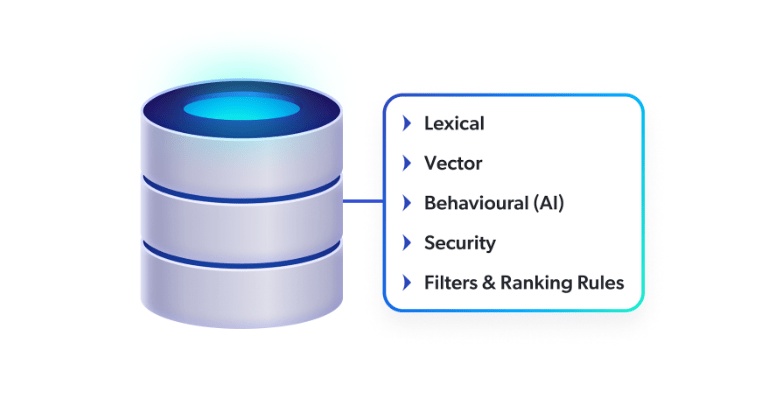Imagine a world where every search query is seamlessly intuitive and deeply personalized — thanks to the revolutionary strides in generative AI.
As businesses dive into innovative models powered by artificial intelligence, the realm of search is undergoing a significant transformation. On the web, Google Search is one of many pioneering this journey with its AI Overviews, merging the traditional search with a dynamic generative experience that captivates users with conversational and contextual interactions.
But what about in the enterprise? These organizations too can take advantage of the opportunities presented by generative experiences.
Generative AI is reshaping how we engage with information, crafting responses and summaries that tap into multiple sources. This evolution from traditional to generative search is more than just a technological shift; it’s a leap toward making search experiences for both employees and customers strikingly human-like, highly relevant, and profoundly engaging. Welcome to the future of search—a generative experience redefining the landscape of information retrieval.
What Is Generative Search?
Generative search is the combination of search capabilities and gen AI advances to provide direct, curated responses and recommendations to a user query. Using large language models (LLMs), generative search goes beyond keyword matching to understand a user’s context and intent to then create a unique response drawing from a massive set of training data and augmented in real-time with up-to-date enterprise knowledge.
A new kind of search experience, generative search offers a more conversational way of interacting with available information. While traditional search returns a list of links drawn from existing information, generative search constructs new answers that synthesize or summarize information so the user can quickly get an answer without clicking through links and evaluating documents. It uses natural language abilities to respond in a human-like way with the capacity to respond to follow up questions.

One can consider generative search to be a subset of AI search, which more broadly means the use of artificial intelligence in search. AI-driven search includes machine learning ranking algorithms, semantic search and natural language processing (NLP). In many ways, AI search injects scalability into search to make the experience faster and more accurate for more users, and engage larger datasets.
Generative search is changing the way we look for and comprehend information, making both processes more efficient and helpful. It impacts our daily lives by answering complex questions with thoughtful analysis. Enterprises can also achieve significant benefit from generative search, due to its potential to improve business processes and provide faster and greater access to information for their employees and customers.
What Are The Benefits of Generative Search?
Traditional search remains an important way to retrieve specific and exact information, such as an address, a quarterly sales report, product or weather forecast. Generative search becomes especially useful for enterprises in scenarios where a user query benefits from a summarized or synthesized answer.
Enterprises can benefit from generative search in several important ways.
Greater efficiency and productivity
Instead of spending time looking for and sifting through links and other sources, employees can use generative search to get fast, accurate answers to a search query. The response can summarize information from multiple sources across the business while using natural language. Generative search has the potential to speed up information retrieval by pulling together the most relevant information so employees can move forward on tasks quickly.
Improved customer support
Generative search empowers both customers and support teams with fast, accurate, and context-aware answers. Whether customers are engaging with a chatbot, knowledge base, or website, generative search ensures they receive relevant, up-to-date information — improving self-service, reducing resolution times, and boosting customer satisfaction.
For support agents, it acts like a co-pilot: surfacing the most relevant content and context about the customer on the other side and the issue they’re having, suggesting responses, and streamlining case resolution, so they can focus on delivering exceptional service.
Timely decision-making
In fast-paced business environments, access to accurate, synthesized information is critical. Generative search accelerates decision-making by surfacing key insights, trends, and recommendations drawn from across the enterprise — from documents, data sources, conversations, and more. Instead of sifting through siloed content or waiting on manual reports, teams can quickly explore complex questions and receive clear, contextual answers — empowering leaders to make smarter, faster, and more informed decisions.
Task automation
In addition to generating responses to user queries, generative search can perform previously tedious or time-intensive tasks to help the business. These may include summarization of customer support tickets, generating code, and making product recommendations. Through LLMs, generative search can also create entirely new content from a query response, such as a piece of marketing content around an important business topic to aid digital marketers.
How Can Generative Search Affect the Customer Experience?
Customers today demand instant, intuitive and personalized experiences. They expect the systems with which they interact to know them and their wants and preferences with little effort on their side. With its ability to understand context and the intent behind a query, generative search enhances customer experiences in significant ways.
Hyperpersonalization
Customers receive tailored responses that take into account context, customer profiles, and their preferences as well as past behavior. Generative search can also retain information about the customer from previous interactions, bringing even greater personalization and continuity to the search experience. For example, generative search can provide product recommendations based on the customer’s behavior on the site, or if logged in, related to products they have bought previously or have registered.
Enhanced self service
Customers are able to get to the heart of their queries quickly in an intuitive, conversational way. They get answers immediately, reducing their wait times and improving their experiences with the company.

Better relevancy and accuracy
The best enterprise generative search relies on a centralized source of information. With Coveo, that source is our unified hybrid index and relevance-focused retrieval capabilities. When information is accessible and assessed for multiple relevancy factors, even customers with complex questions receive responses that are accurate, current, and consistent.
What Makes a Good Generative Search Experience?
Generative search offers businesses and their customers a lot of opportunities — from faster access to the right information to hyperpersonalized customer experiences. But successfully delivering an intuitive search experience using generative AI requires several components to work.
Well-maintained content
Regularly maintaining and updating the underlying data so that it is accurate, timely, complete and consistent across systems is crucial. Generative search only functions well with healthy, high quality data.
Relevant reading: 6 Data Cleaning Best Practices for Enterprise AI Success
Unified index
The gen AI in search must have access to all relevant sources of content and data to truly provide an accurate, comprehensive response. With Coveo, this is made possible through a unified index that centralizes and normalizes content across repositories and storage systems.

Robust retrieval capabilities
Hallucinations are a major obstacle to enterprise adoption of generative AI. These “confident errors” can come from multiple places — incomplete or biased training data, or if the model is simply given too much free reign when it is asked to make connections to deliver an answer. The most effective way to mitigate hallucinations and other errors is retrieval augmented generation (RAG), which grounds an AI model in approved enterprise source content, connecting the model to an accurate and up-to-date source of relevant information.
Advanced Retrieval Augmented Generation (RAG)
While RAG is essential for enterprises to maintain control over the data a large language model uses, not all RAG techniques are created equal.
The accuracy and relevance of the retrieval depend on an excellent search foundation. Poor search infrastructure leads to poor retrieval — resulting in an LLM being fed with irrelevant information that results in a poor answer.
Instead, enterprises with a vast amount of content scattered across many repositories need to investigate advanced RAG techniques to ensure the data used is company approved and adheres to security and privacy regulations.
Relevant reading: The Power of Precise Information: 8 Ways Coveo’s Passage Retrieval API Unlocks Content
Generative Search Experiences Challenges
Despite the power and potential of combining generative AI capabilities with traditional search, obstacles can get in the way of a good search experience. Addressing these challenges will position enterprises to take full advantage of generative AI for their information retrieval needs.
Messy data
Poor data quality can prevent search systems from working correctly. With AI models relying on massive amounts of data, that data needs to be clean and structured for better search performance. When data is not well maintained, an AI-powered search acts from bad data, leading to an irrelevant or inaccurate search result. Putting a good data cleaning practice in place ensures businesses maximize on generative search.
Scattered content
Another issue enterprises encounter with search is content that resides across different repositories, systems and databases. This makes content difficult to find and retrieve, leading to inconsistencies like duplications, various file formats and differing versions. Scattered content lowers the quality of generative search.
Siloed search
Enterprises also face the challenge of siloed search systems, meaning search is not connected across the company. Instead, native search embedded in point solutions chosen to solve individual problems create a series of cul-de-sacs that searchers must navigate, assuming they even know where to look. Users are unable to access data or information stored in a different system leading to bottlenecks in completing tasks and restrictions on knowledge sharing. As a result, there is a need for interoperability and standardization across the various systems of search.
Insufficient retrieval infrastructure
An LLM on its own is limited to its training data. In using generative search at an enterprise scale, organizations need an advanced retrieval infrastructure that pulls relevant and updated information, maintains data privacy and security, and brings together data from across multiple repositories.
Relevant reading: Choosing the Right Retrieval Method for Your AI Project
Successful Generative Search Experiences
Many organizations have already implemented generative search into their business successfully, delivering great search experiences for both employees and customers and even saving on costs for the organization.
- Xero, a provider of cloud-based accounting software, used generative search to unify a scattered customer support experience. Xero uses generative AI today to provide customers and employees with immediate, secure and accurate answers, speeding up resolutions and building trust with customers. The company experienced a 20% increase in self-service resolutions and 40% reduction in costs.
- SAP Concur used gen AI to scale accurate, fast service for millions of customers across its assisted support and self-service platform. The provider of travel and expense management solutions was able to realize its goal of delivering high-quality service experiences that drove customer renewals along with a 80% reduction in search queries per customer visit.
- Forcepoint, a cybersecurity firm, faced the challenge of knowledge silos and a search experience that left customers and employees struggling to find relevant information. Through generative AI, Forcepoint was able to provide human-like responses to queries that are always up to date, relevant and accurate. The company experienced a 200% increase in case deflection.
Learn more about the Coveo AI-Relevance Platform, and what it can do for your enterprise.
Dig Deeper
As companies incorporate AI rapidly across their businesses, generative search is emerging as a significant technology that gives users answers to their complex questions and deepens engagement with a business.
AI search experts at Coveo can help guide the way to a successful generative search implementation. We’re divulging what leading enterprises discovered when implementing Coveo Relevance Generative Answering in their digital self-service experiences.


